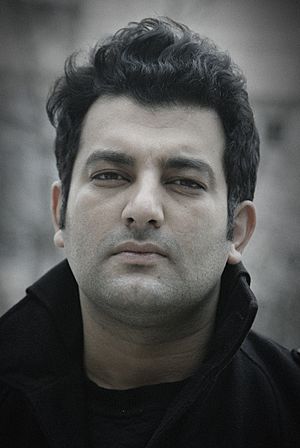Hossein Rajabian facts for kids
Quick facts for kids
Hossein Rajabian
|
|
|---|---|
 |
|
| Born | 5 July 1984 |
| Nationality | Iranian |
| Education | Dramatic literature (Unfinished) |
| Occupation | Filmmaker, writer, photographer |
| Awards | COR AWARD 2022 |
Hossein Rajabian (Persian: حسین رجabiان; born 5 July 1984) is an Iranian filmmaker, writer, and photographer. He is known for his strong belief in freedom of speech for artists and for speaking out against rules that stop artists from creating freely. He faced challenges because of his filmmaking.
Contents
Hossein Rajabian's Artistic Journey
Hossein Rajabian began his journey in a theater school. He later started making short films and documentaries. His work includes making feature films, writing movie scripts, and creating photography projects. He also led workshops to teach others about filmmaking.
He started studying dramatic literature at a university in Tehran but could not finish his studies. He was also accepted to a university in Vienna, Austria, to study cinema and theater. However, he was stopped from leaving his country and could not continue his education abroad.
Films and Projects
Hossein Rajabian has worked on many creative projects. Here are some of them:
Short Films
- So So (2003, 6 minutes)
- Navigation (2005, 43 minutes)
- To Revolution Square (2006, 22 minutes)
- Some Redundant Word in The Dictionary (2010, 20 minutes)
- Lines (2010 to present)
Feature Films
- The Upside-down Triangle (2016, 106 minutes)
- Creation between Two Surfaces (2019, 95 minutes)
Film Workshops
- Film Workshop The Experimental & Creatively attitude
Photography Projects
- People in distance is a black and white photography project by Hossein Rajabian.
Movie Scripts
- The stone falls in water (2009)
- The Upside-down Triangle (2011)
- Creation between Two Surfaces (2019)
Challenges and Support
After finishing his first feature film, Hossein Rajabian faced difficulties with authorities in October 2013. He was held for over two months. Later, in 2015, a court ruled that he had done things that were not allowed, like making films that the government did not approve of. He was given a sentence, which was later changed to three years in prison and other conditions.
Time in Prison and Protests
Hossein Rajabian was sent to Evin Prison in Tehran. While there, he protested against what he felt was an unfair trial and a lack of medical care. He went on a hunger strike, which means he refused to eat. This protest lasted for many days and brought attention to his situation.
After a long struggle, he was allowed to leave prison temporarily for medical treatment. He spent three years in prison before being released. His release happened because many people and organizations around the world spoke out and put pressure on the authorities.
Global Support for Hossein Rajabian
Many important people and groups around the world showed their support for Hossein Rajabian.
- Ban Ki-moon, who was the Secretary-General of the United Nations, mentioned Hossein Rajabian's situation in a report and asked for his release.
- Asma Jahangir, a UN expert on human rights in Iran, also called for his release.
- Wilfred Moore, a Canadian Senator, spoke in support of him.
- Åse Kleveland, a Norwegian artist and political leader, also showed her support.
- Amnesty International, a global human rights organization, launched a campaign. They made a video with Philip Luther, their head, asking artists worldwide to support Hossein Rajabian.
- Famous people like actor Johnny Depp and musician Peter Gabriel started a campaign called "Art is not a Crime" to protest against censorship and support artists like Rajabian.
More than 12,000 people signed a petition asking Iranian authorities to review his case. The United Nations Human Rights Committee also passed a resolution against the Iranian government because of human rights concerns, partly due to Hossein Rajabian's hunger strike. The United States Senate also extended sanctions on Iran related to human rights. People in European countries held protests outside Iranian Embassies, showing his photos. The United States Department of State also mentioned his situation in their 2016 report on human rights in Iran.
Films Released in Protest
To protest his sentence and because his film materials were taken, Hossein Rajabian released a copy of his film The Upside-down Triangle online. His second film, Creation between Two Surfaces, was released for free on the internet in February 2020. He did this to show his stand against censorship and to support people protesting in Iran.
Media Coverage of His Case
News about Hossein Rajabian's situation was reported by many major news organizations around the world. These included The Washington Post, The Guardian, The Independent, Al Arabiya, BBC News, Le Figaro, CNN, and Al Jazeera.
Many artists and activists also spoke out. Jared Leto, an Oscar-winning actor, and Ai Weiwei, a Chinese artist, were among more than 20,000 artists who joined a global campaign by Amnesty International. Other notable figures like Reza Deghati, Kayhan Kalhor, Nazanin Boniadi, Shirin Neshat, Nasrin Sotoudeh, Bahman Ghobadi, Shirin Ebadi, and Jafar Panahi also shared news about him on social media.
Organizations like PEN International, International Campaign for Human Rights in Iran, and Amnesty International also released statements asking for his release. Many people involved in media and cinema in Iran and other countries sent a letter to Iran's Minister of Culture and the UN Special Rapporteur for human rights in Iran, Ahmed Shaheed, asking for Hossein Rajabian and others to be released.
See also
 In Spanish: Hossein Rajabian para niños
In Spanish: Hossein Rajabian para niños
- Culture of Iran
- Islamic art
- Iranian art
- Iranian art and architecture
- List of Iranian artists
Images for kids


